
Some time ago I reviewed Andromeda Conquest. Andromeda Conquest may be one of the earliest computer 4X (along with Galaxy and Galactic Empire) but as a solo experience it was a disaster : without any AI faction, it is only a race against the clock, without any target in the manual. I could not rate the game, and had the feeling I had missed something.
Well, with the DataDrivenGamer and commenters Dayyalu and Porkbelly, we organized a 4-player Play-By-E-Mail (PBEM) to try and give the game a fair chance. So back to conquering Andromeda !
Turn 1 – A new beginning.
I am the ants insectoids again, the DataDriven gamer has the robots, Dayyalu the “aquatic” civilization (“fishes” for short), and Porkelly plays the molluscs (“snails” for short). The galaxy is large – 48 systems – and the first player to control 10 systems wins, so I might not even run into all the other players.
The computer gives me control of system #28. As every starting system in the game, it produces just enough resources to build one colony ship (“Echo” ship, cost 10) or five scout / combat ships (“Rama” ships, cost 2). There is some debate between us on whether the best opening is making a colony ship or scout ships, but in my case there is a system in range of a colony ship (two “tiles”), so colony ship it is. I immediately move it to system #32

I am lucky, planet #32 has an acceptable colonization price (7) that will earn me 5 extra resources every turn :
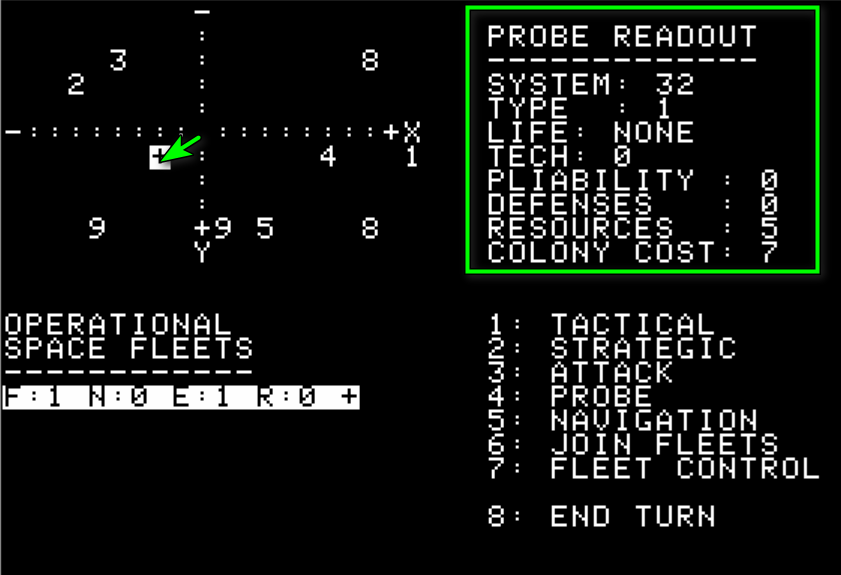
At this point I also check the universe map, and I don’t like what I see :
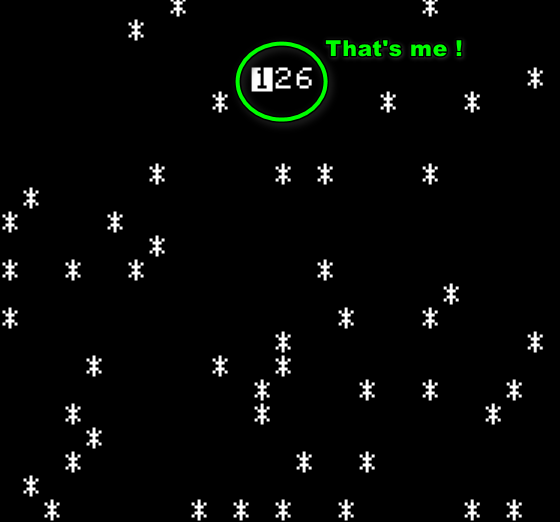
Systems are pretty sparse in my area of the galaxy, with systems being spaced by two tiles or more – keep in mind you can only colonize if you are orbiting a system at the beginning of a turn. I feel like I’m starting at a strategic disadvantage compared to players who have spawned in most other locations on the map. Oh well, I will compensate with more colony ships.
Turn 2 – First contact
Before you can check the general situation, the game tells you gives you a list of your systems and your fleets, and asks whether you want to colonize and what ships you want to build. For now, easy choice – Yes I do.
Having colonized system #32, I have no other system in range, I am left with no other system in range for colonization next turn, and 3 in resources – just enough for a scout ship (you cannot store resources between two turns).
I can finally check the map and what do you know, an alien fleet is spotted already !

Well, it is far away, and hopefully whoever it is will be focused on its own development – after all if you wage war in a four-player game you give the advantage to the two remaining players, don’t you ? I scout ahead the closest system with my Rama, confirm that it is colonizable (even if mediocre), and move my colony ship in that direction. Hey, is that another alien fleet ?
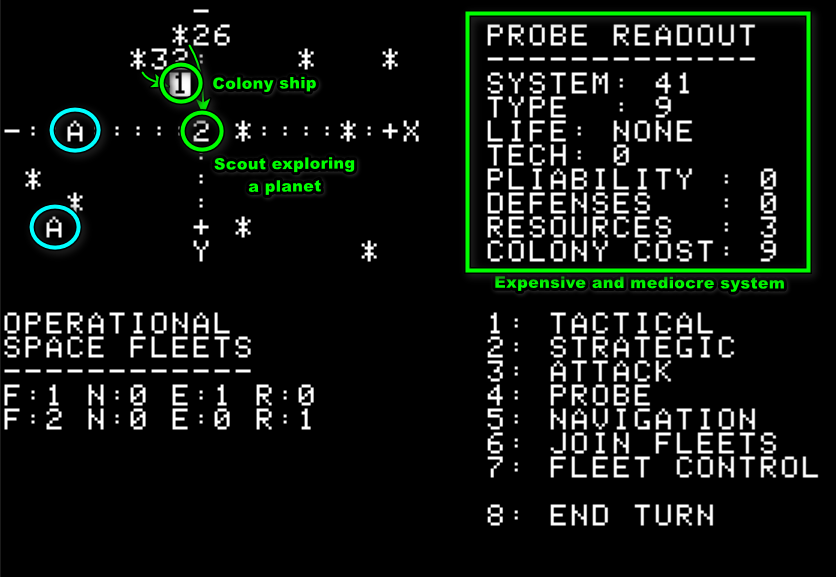
Turn 3 – First probe
The following turn, I build a second colonization ship (+1 Rama escort) in system #26 and another scout in system #32. When I can finally check the map, I see no aliens at first, and start spreading out a bit before realizing there was an alien fleet hovering above system #32 : the game is so primitive alien fleets are displayed “behind” your own fleet so you need to refresh the tactical view WITHOUT accelerating the emulator so that you can see the alien fleet before it is “overwritten” by the display of your fleet.
This alien “fleet” is actually one of Porkbelly’s snail scout ships. Nothing I can do, so I can only taunt the snails a bit on the forum (“Food ! Food has been delivered. It will be eaten soon, if it does not leave”) and move on.

From the forum and the email exchanges I had with the other players, I know that the fish and the robots are already at war, a confrontation that Porkbelly will later call “the fish & chips war“. This means I am the one who will have to counter Porkbelly, especially since I know from exchanges with Dayyalu that I don’t have any other neighbour.
Turn 4 – First war
I need to strike fast at Porkbelly ! Instead of colonizing a new system that will take 3 turns to be profitable, I decide to build a combat cruiser (Nova : cost 12), with a Rama tagging along. I do well, or so I think initially, as there is indeed an alien fleet coming at me, at the right of the map, orbiting over some neutral system not far from me. I send first a scout, and it confirms it is a group of 5 Ramas. It must be a combat group incoming. Well, it’s not me waging war if the other side was about to attack me, right ? I will destroy that fleet.
At this point in the game, I don’t understand the rules well and I believe Nova cruisers to be far superior to Rama scout. I move my Nova the enemy, destroying two scout ships. Huge mistake, Nova deal roughly twice the damage of a Rama, but they cost 6 times more and have exactly the same number of HP as a Rama : 1. They are just destroyed last.
What I should have done is destroy the system that the Ramas were orbiting over. That’s what NOVA are for, and it would have made future attacks in my direction much harder.
In any case, my other fleets (2 colonization ships, one with escort, one without) carry on their exploration : at the top of the map I find a planet already colonized by another insectoid civilization – I would need to destroy them before colonizing, and I don’t have the means to do that I will not attack fellow insects. In the middle of the map, I find a poor but cheap system : my target for next turn.

This is the situation at the end of turn 4 :

Turns 5 – 6 First defeats
The turn starts with my Nova fleet gone – removed from the galactic map by Porkbelly’s spacefaring snails. This should have been obvious if I had known the combat rule, but I did not. After colonizing a new world, and with 10 in resources left, I decide to build… only 3 Rama (out of 5 possible) – allocating the rest to passive defence. Anoter poor decision, explained by my belief at this point that Ramas are weak combat units, when in fact they are the best one (and really the only one).
I spread out my Ramas to draw attention, while attempting a dash for the last world at the top of the map. Meanwhile, my other Echo colony ship is getting away as fast as it can by the right :

My attempt to confuse Porkbelly is a failure. He obviously understands that the group orbiting the planet must be the one with the colony ship, and turn 6, I discover that my Echo ship at the top of the map was found, intercepted and destroyed. One of my scouts also found a large enemy fleet of 7 ships not too far away. Worrying.
At this point, the war between Dayyallu and DataDrivenGamer triggers a code review, and thanks to Porkbelly’s exegesis, suddenly everyone discovers how battles really work. Uh oh, I have been barking clicking my mandibles at the wrong starship the whole time.
Now aware that I need to rely on Ramas for my defence, I build 9 of them in two groups that I put behind my planets, ready to pounce !
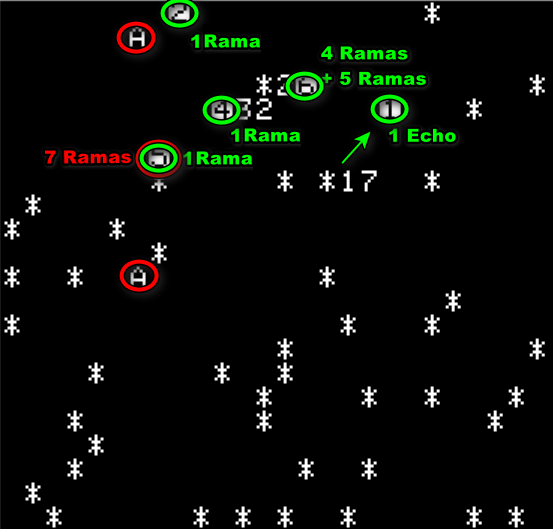
I am in discussion with the robots, who have their own epic space battles with Porkbelly. I expect them to put more pressure while I accumulate a fleet, so hopefully I will be able to counter-attack. The problem is that the robots have to allocate large resources to the fish & chips war, and Porkbelly does not seem to be under too much pressure. But I am sure it will turn fine.
At least my Echo finds a new system, to be colonized the following turn :

Turn 7 – Respite
After colonizing system #38 and investing the rest into Ramas (7 of them), I check the situation to find a small group of gasteropod Ramas orbiting system #32. They are all destroyed.

More worrying, one of my scouts detect a massive fleet inbound : 1 Nova, 1 Echo escorted by 8 Ramas. I can destroy this if I am in defence, but still – clearly Porkbelly has quite the industry : this fleet is worth 38 points, it would represent more than 2 turns of production for me. I will be waiting for it – certainly, the DataDrivenGamer will strike from the bottom of the map anytime soon :

For added frustration, my Echo is heading toward a planet that turns out to be absolutely sterile : 0 in production.

Turns 8 to 10 – The battle for Klendathu
The enemy battle fleet is upon me ! Not the planet-killing fleet, no, but yet another fleet of 13 Ramas orbiting world 32, a system that the molluscs call “Klendathu“.

They destroyed 4 of my Ramas, but I could buy 10 to replace them. I gather almost everything I have – 19 ships – and attack the hostile aliens. At the end of the turn, the enemy fleet is down to 2 ships. Of course, the enemy fleet with the Nova, Echo and 8 Ramas is still inbound.
At the beginning of the following turn, most of my battle fleet is gone : I have 5 Ramas left orbiting Klendathu, plus 3 nearby. I am building 10 new to replace them, but it looks like an industrial war I cannot win : there are now 25 Ramas, in addition to the Nova ship.

After a long battle, I manage to reduce their number to 11…

… and the next turn, Klendathu is gone.
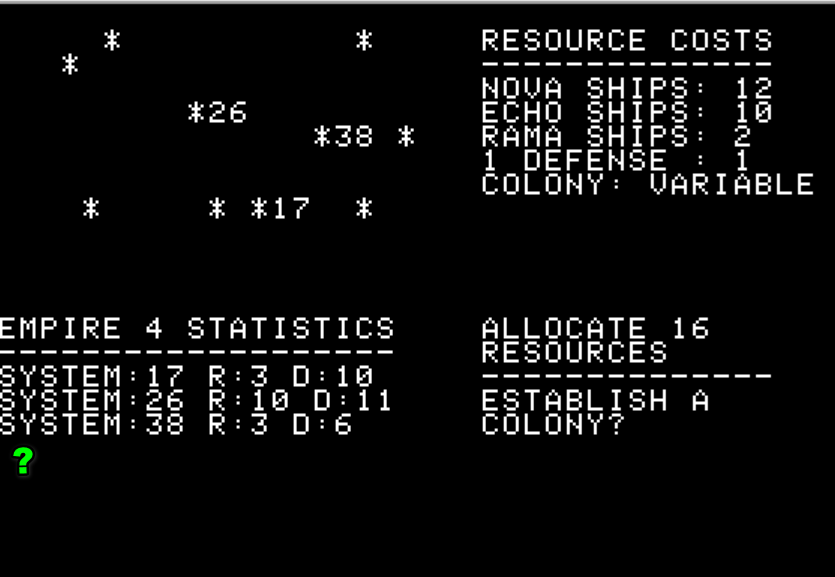
Instead, I find a snail fleet of 30 Ramas, in addition to the Nova and an Echo that Porkbelly probably regrets bringing (you cannot break up fleets, so he is stuck with it and it slows down his whole fleet).
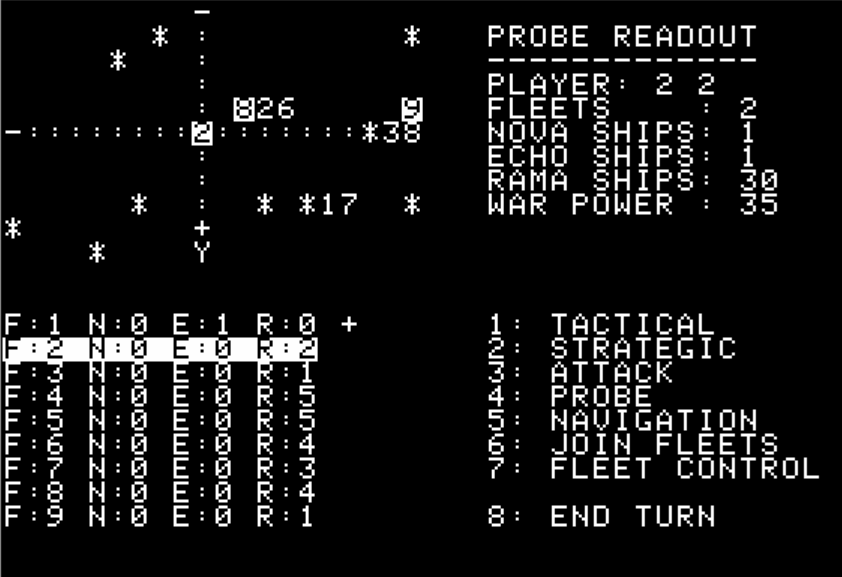
I was already outproduced, but losing system 32 / Klendathu puts me back by 2 Ramas and half a turn. My robot allies are doing what they can, but they have the fish to handle as well. Or so they claim. I do not see them, they do not see me.
Meanwhile, my Echo, after bouncing between dead worlds to very-much-alive-and-ready-to-defend-themselves worlds, finally reaches the system on the right border of the map : it is a very wealthy world, expensive to colonize, but well worth it :
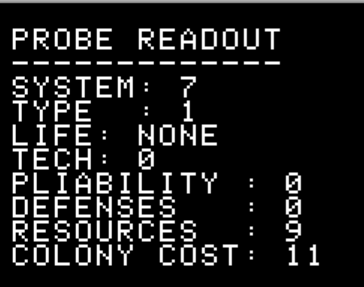
A decent place for a last stand ! Of course, I need to colonize it right now, because with a cost of 11, I may lose the capacity to even colonize it soon.
Not that it matters much, the robots tell me they counted the systems owned by the molluscs and they expect them to reach 10 systems any moment now – and as they are allied with the fish there is nothing the robots can do.
Turn 11 – 12 : The last anthill
The fertile system far away from system-destroying snail-manned cruisers is colonized turn 7. The colonization price means I can only build 2 extra Ramas that turn. They won’t be able to do much against the fleet of 44 Ramas orbiting my main system.
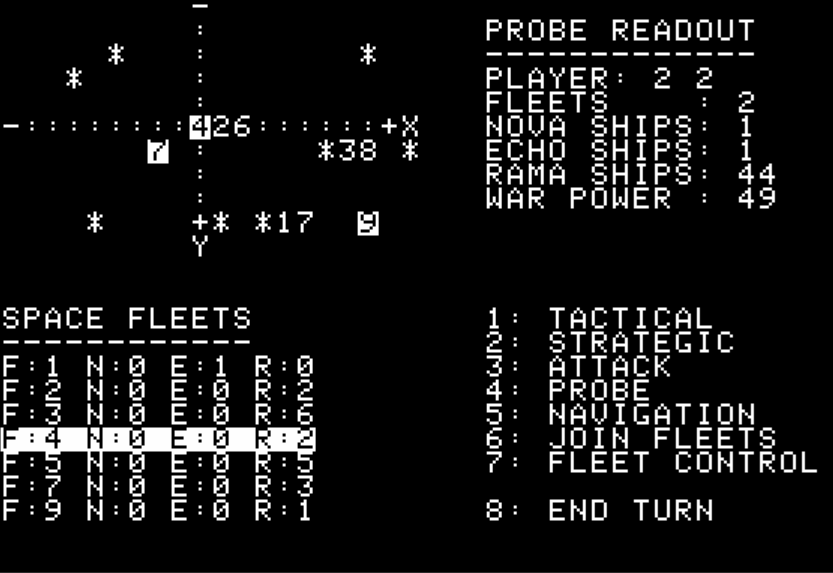
Turn 12, without any surprise, my starting world is destroyed. I am now in exile. My few survivors in the area spot more than 70 ships at this point…
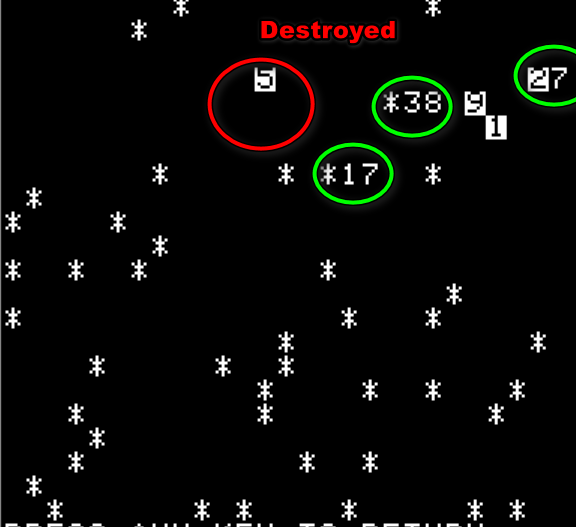
It is the last turn. There will be no reckoning, Porkbelly’s molluscs colonized their 10th system the previous turn, and when the turn comes back to them, they have won !
Final thoughts
Porkbelly was well ahead of all the other players, reaching 10 systems and 67 in production (as per the last turn) when all the other players never passed 5 :
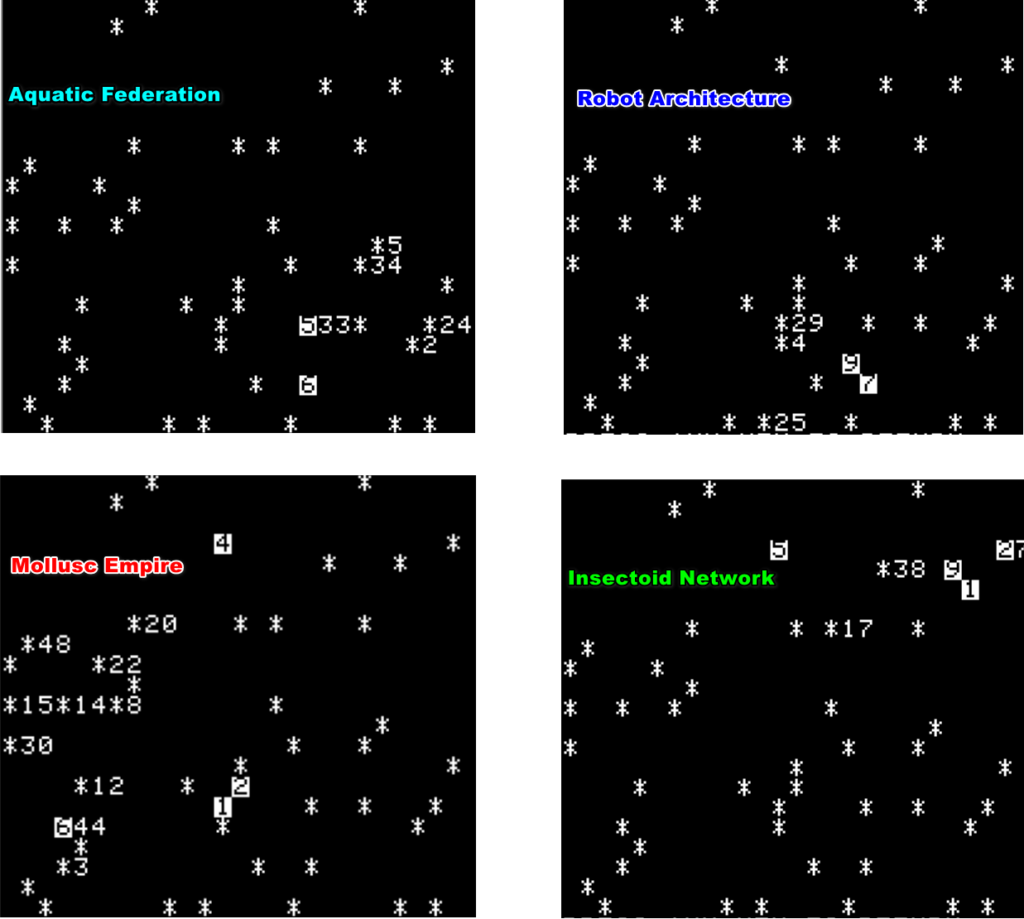
The aquatic civilization ended with 5 systems and 26 in production, the robots had only 3 systems, but good ones as they totalled 24 in production. It is a good design decision to end the game after a player controls 10 systems, I thought it would be too early but there were plenty of battles from the beginning, the victor was pretty clear and it kept the game short and sweet.
From my point of view, the turning point was turn 4 with no less than four mistakes in the same turn.
- First mistake : I produced a Nova.
- Second mistake : I read the accumulation of ships by Porkbelly as aggressive, whereas according to his notes those ships were guards, as he had decided to follow my demand that he retreats.
- Third mistake : Even though I knew that the slow development due to the scarcity of systems in my area meant I would be underproducing my opponent, I nonetheless attacked, rather than waited in defensive position (a fleet that does not move can attack twice).
- Last mistake : I could have directly blown out the undefended world his units were orbiting, and it would have made attacking me slightly more difficult (and his growth slower, though the planet had not yet been colonized). Instead, I attacked his ships for meagre damage.
I believe I would have lost even without this string of mistakes, but at least I could have been second and not stuck in desperate defence for the second half of the game.
Still, the game has shown it could offer more than I gave it credit for. The UI is awful, the game is really dependent on luck (having good systems near your starting location is a gamechanger), the economy snowballs. Still, the game is simple to understand yet forces you to take decisions every turn : send scouts or concentrate, colonize poor & expensive worlds or move on, attack or defend, go for the fleets or try to destroy the worlds. It certainly lacks depth : only three types of ships, no accumulation of resources from one turn to another, newly colonized systems can churn whole fleets the turn they have been colonized…
The real strength of this game is that for 4X, its simple ruleset allows it to be played pretty fast : let’s say 3 minutes by turn on average, for probably no more than 15 turns per game. Good enough for hotseat in an evening, perfect for PBEM – for this price you can probably forgive the decisive role of luck. In multiplayer, I am going to rate the game (simply) obsolete. I thank Porkbelly, Dayyallu and the DataDrivenGamer for accepting to be part of this little experiment indeed. I am not sure it will be the object of a full-fledged article, but I am now recruiting for the Wreck of the BSM Pandora.
Cornered around Klendathu, I have not see anything of the Fish & Chips war, but you can also check the DataDrivenGamer’s point of view of the campaign as he struggled in a two-fronts war. You can also check Porkbelly’s notes to understand what happened from his point of view.